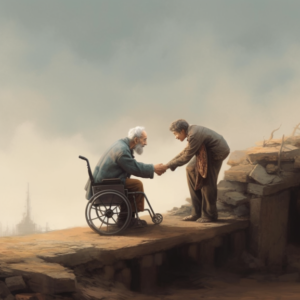In today’s increasingly diverse society, discrimination still lurks behind many of the interactions we engage in daily. From the workplace to our personal lives, various forms of prejudice, such as racism, sexism, ageism, and more continue to impact lives in significant ways.
This blog post will unveil the different faces of discrimination by exploring their definitions and manifestations while highlighting the effects on mental and physical well-being.
We will also discuss how intersectionality plays a critical role in understanding these discriminations and propose methods for combating them effectively.
 Key Takeaways
Key Takeaways
- Discrimination takes many forms such as racism, sexism, ageism, ableism, homophobia and transphobia, and religious discrimination.
- Understanding intersectionality is crucial to combatting discrimination effectively because individuals often face multiple layers of oppression depending on their unique identities.
- Discrimination can have far-reaching consequences for marginalized communities, affecting mental health and well-being barriers, economic disadvantage and social exclusion. Addressing it involves legal actions against discriminatory practices at work or in other institutions as well as promoting diversity and inclusion initiatives across different sectors.
- Combating discrimination requires education and awareness-raising campaigns, which are aimed at changing negative stereotypes associated with diverse groups, while also encouraging positive messaging about the contributions made by these communities towards society’s growth.
Understanding Discrimination
Discrimination is defined as unfair treatment or unequal opportunities based on various characteristics, such as race, gender, and age, with both systemic and individual discrimination playing a significant role in perpetuating inequality.
Defining Discrimination
Discrimination is a pervasive issue that manifests in various aspects of everyday life. At its core, discrimination involves treating individuals unfairly or unequally based on certain characteristics, such as race, gender, age, disability, religion, nationality or other factors.
One commonly cited example of discrimination is racial profiling – when law enforcement officers target people based on their ethnicity rather than evidence of criminal activity.
Discriminatory practices are also apparent in gender pay gaps where women often earn less than their male counterparts for performing the same job; age discrimination during job interviews when applicants are deemed “too old” or “too young”; and denial of housing opportunities because of religious beliefs.
Systemic And Individual Discrimination
Systemic discrimination, also known as institutional discrimination, occurs when rules, policies, or practices within an organization create or perpetuate disadvantage for certain groups.
For example, a company’s hiring process that appears neutral on the surface may actually favor applicants of a certain race or gender due to biases in evaluation criteria.
Individual discrimination takes place at a more personal level and involves unfair treatment by one person towards another based on preconceived notions and stereotypes. This form of prejudice could manifest in various scenarios such as a store owner refusing service to someone because of their race, gender identity or disability.
Intersectionality And Its Role In Discrimination
Intersectionality is a critical concept in understanding and combating discrimination, as it acknowledges the interconnected nature of various social categories such as race, gender, class, sexual orientation, and gender identity.
This perspective takes into account that individuals often face multiple layers of oppression depending on their unique identities.
The importance of considering intersectionality when examining instances of discrimination cannot be overstated. Discrimination often occurs at the intersections of multiple social categories, making it crucial to acknowledge and examine these complex relationships in order to develop effective strategies for fighting it.
One instance illustrating this is the case involving LGBTQI+ individuals who may face heightened levels of bias due to their sexual orientation/gender identity combined with other factors like race or religion.
Moreover, acknowledging intersectionality encourages us to challenge stereotypes entrenched within society which perpetuate harmful biases across different groups. It fosters empathy by creating greater awareness about diverse experiences faced by marginalized communities while also promoting inclusion through policy reform and education initiatives aimed at dismantling systemic barriers ingrained within societal norms.
Different Forms Of Discrimination
Discrimination takes various forms, including racism, sexism, ageism, ableism, homophobia and transphobia, and religious discrimination.
Racism
Racism is a form of discrimination that targets individuals or groups on the basis of their race or ethnicity. It can be manifested in various ways, such as negative stereotyping, exclusion from certain opportunities or privileges, or even physical violence and hate crimes.
Racism often stems from conscious or unconscious bias and prejudice towards members of a particular racial group.
The impact of racism can be far-reaching and damaging both for individuals and society as a whole. From systemic racism in institutions like healthcare and education to interpersonal discrimination experiences faced by everyday people on the streets, it affects mental health, well-being barriers, economic disadvantage within targeted communities, social exclusion as well as representation issues across different industries.
Sexism
Sexism is a form of discrimination that refers to treating someone unfairly or unequally based on their gender. It involves prejudice, stereotypes, and biases about specific genders, with males dominating most positions of power while females are relegated to subservient roles.
Examples of sexism include the gender pay gap where women earn less than men for the same job position and sexual harassment in the workplace where women are subjected to unwanted advances or comments from male co-workers or superiors.
According to studies, one in three women worldwide has experienced physical or sexual violence at some point in their lives due to sexism.
Ageism
Age discrimination, also known as ageism, refers to the prejudice and discrimination that is directed towards people based on their age. This type of discrimination may manifest in various forms such as denying employment to older individuals, treating them unfairly in the workplace, or even dismissing their opinions.
Ageism has a significant impact on an individual’s mental health and overall well-being.
This form of discrimination is prevalent in many areas such as healthcare, employment, housing, and social services. For example, elderly patients often do not receive appropriate medical attention due to assumptions surrounding their cognitive abilities while seniors’ contributions in the workplace are sometimes ignored despite their extensive experience.
According to studies by AARP Foundation Litigation and The Equal Employment Opportunity Commission (EEOC), ageist attitudes persist today with one-third of workers aged 55 plus having experienced or witnessed some sort of ageism at work.
Ableism
Ableism refers to discrimination against individuals with disabilities or impairments. This type of discrimination can come in various forms, including inaccessible environments, exclusion from social events and activities, or stereotyping people with disabilities as less capable.
The impact of ableism on individuals with disabilities can lead to higher rates of unemployment, poverty and lack of access to education. It’s important to promote inclusion and recognize the value that diversity brings in every aspect of life.
A society that values accessibility creates better opportunities for people living with a disability by providing more paths for success such as making workplaces accessible or implementing accommodations at universities.
 Homophobia And Transphobia
Homophobia And Transphobia
Homophobia and transphobia refer to discrimination against individuals who identify as LGBTQI+. Homophobia is the fear, hatred, or intolerance of individuals who are attracted to members of the same sex.
Transphobia refers to prejudice towards transgender people. Discrimination against these groups can take many forms such as harassment in public places or denying them jobs, healthcare access, and housing.
In some countries, laws criminalize homosexuality with prison sentences ranging from fines to life imprisonment or even the death penalty.
Religious Discrimination
Religious discrimination occurs when an individual or group is treated unfairly on the basis of their beliefs, practices, or affiliation with a particular religion. This type of discrimination manifests itself in various ways, including harassment and exclusion from certain activities or opportunities.
For instance, Muslim women who wear hijabs have reported being targeted for acts of discrimination such as being refused employment and subjected to verbal abuse while commuting.
According to data from the Equal Employment Opportunity Commission (EEOC), religious-based complaints under Title VII of the Civil Rights Act have steadily risen over the years.
Religious discrimination can lead to economic disadvantage and marginalization – particularly for those who belong to minority faiths – ultimately affecting mental well-being as well.
The Impact Of Discrimination
Discrimination can have significant impacts on mental and physical health, lead to economic disadvantages, and result in social exclusion.
Mental And Physical Health
Discrimination can have a devastating impact on both mental and physical health. Studies show that those who experience discrimination are more likely to suffer from depression, anxiety, and stress-related illnesses.
Discrimination can also lead to physical health problems such as high blood pressure and heart disease.
Furthermore, discrimination often leads to economic disadvantage which adversely affects access to quality healthcare, healthy food choices or living conditions – further compounding the issue of poor mental and physical health outcomes.
It is crucial that we address the issue of discrimination not only because it erodes our shared values around human rights but also because it has tangible consequences on well-being barriers affecting vulnerable members in our communities across race, genders, age, religions, abilities, sexual orientation, gender identity, etc.
Economic Disadvantage
Economic disadvantage is one of the significant impacts of discrimination. Discrimination based on race, gender, and age can lead to economic inequalities that shape individuals’ financial well-being.
For instance, women and minorities are often paid less than their white male counterparts for the same job. Research also shows that people with “ethnic sounding” names have a harder time getting hired despite having comparable qualifications to those with “white-sounding” names.
Ageism is another form of discrimination that has detrimental effects on an individual’s finances. Older workers may experience difficulty in finding a new job after being let go or retiring or may face issues accessing benefits since they’re no longer part of the workforce actively.
Furthermore, older people tend to have more health issues than younger folks resulting from years of wear-and-tear; this increases medical bills and other costs associated with aging.
Social Exclusion
Social exclusion is another impact of discrimination that cannot be ignored. When individuals or groups face discrimination, they may also experience social exclusion, which is the process of being shut out from society and denied access to resources and opportunities.
This can include being excluded from certain spaces or events based on race, gender, religion, sexuality, or other factors.
For example, LGBTQI+ individuals who face discrimination in their workplace may also feel excluded from work-related social events due to their sexual orientation or gender identity.
It is important for society to recognize the harmful effects of social exclusion and take steps towards creating inclusive environments where everyone has equal access to resources and opportunities regardless of their background.
Combating Discrimination
We can combat discrimination through legal action, social activism, education and awareness, and promoting diversity and inclusion.
Legal Actions
Legal actions can be taken to combat discrimination at both the individual and systemic levels. Here are some examples of legal actions that can be taken:
- Filing a complaint with a government agency such as the Equal Employment Opportunity Commission or the Department of Housing and Urban Development.
- Pursuing legal action against an employer, housing provider, or other discriminator through lawsuits or mediation.
- Advocating for stronger anti-discrimination laws and policies through lobbying efforts.

In addition to these legal actions, individuals can also take steps to educate themselves about their rights and raise awareness about discrimination in their communities. Doing so can help create a more inclusive and equitable society for all.
Social Activism
Social activism plays a vital role in combating discrimination. Here are some ways activists can make a difference:
- Organizing protests and demonstrations to raise awareness and attract media attention.
- Using social media platforms to spread information, share personal stories, and connect with others who are passionate about ending discrimination.
- Promoting diversity and inclusion in the workplace through initiatives such as mentorship programs, bias training, and promoting diverse hiring practices.
- Lobbying lawmakers to pass anti-discrimination legislation or strengthen existing laws.
- Supporting organizations that provide legal assistance and other resources for individuals who have experienced discrimination.
- Encouraging community involvement through volunteering, fundraising, and networking events.

Social activism can create positive change by amplifying marginalized voices and holding institutions accountable for their discriminatory actions.
Education And Awareness
Education and awareness are essential tools in combating discrimination. Here are some ways to promote education and awareness:
- Incorporate diversity and inclusion training programs in schools, workplaces, and organizations.
- Encourage open discussions about discrimination to foster a culture of inclusivity.
- Provide resources and information on the different forms of discrimination to raise awareness among individuals.
- Foster a learning environment that values diversity by highlighting cultural traditions, holidays, and history.
- Promote positive representation in media to counter negative stereotypes.
- Encourage advocacy for marginalized groups through community involvement, voting, and advocating for policies that support equity.
Studies have shown that education and awareness can lead to significant improvements in attitudes towards diverse groups. By promoting these practices, we can work towards creating a more inclusive society free from discrimination.
 Promoting Inclusion And Diversity
Promoting Inclusion And Diversity
Promoting inclusion and diversity is crucial in combatting discrimination. Here are some ways to promote it:
- Encourage open communication and dialogue between different groups.
- Foster a culture of acceptance and respect for all individuals.
- Provide equal opportunities for employment, education, and advancement regardless of a person’s identity.
- Implement policies that prevent discrimination in hiring practices, workplace behavior, and access to services.
- Take steps to address unconscious bias through training programs and awareness campaigns.
- Celebrate cultural diversity through events and activities that showcase different traditions and customs.
- Collaborate with community organizations to promote inclusion and diversity initiatives.
- Ensure that leadership reflects the diversity of the population they serve.

Incorporating these strategies can help create a more inclusive society where everyone feels valued and respected regardless of their background or identity.
Addressing Intersectionality
Understanding intersectionality is crucial in combating discrimination; by recognizing the unique experiences of individuals and the intersecting identities that contribute to their oppression, we can create more effective solutions for promoting diversity and inclusion.
Understanding Intersectionality
Intersectionality refers to the interconnected nature of social categories like race, gender, sexuality, class, and religion that affect an individual’s experiences of discrimination and marginalization.
It recognizes that people experience multiple forms of discrimination and oppression simultaneously due to their intersecting identities.
The importance of addressing intersectionality lies in understanding how various aspects of identity impact individuals’ opportunities for success. By recognizing how different forms of oppression interact with one another, we can work towards creating more inclusive environments that allow everyone to thrive regardless of their background or identity.
Importance Of Addressing Intersectionality
Addressing intersectionality is crucial when tackling discrimination because individuals can be discriminated against for various reasons, including their race, gender, sexuality, religion, and more.
Intersectionality recognizes that forms of oppression intersect and overlap with one another. For example, a black woman may face discrimination not only based on her race but also her gender.
Ignoring intersectionality in the fight against discrimination risks perpetuating further marginalization by failing to address the complex nature of people’s lived experiences.
Addressing intersectionality means acknowledging that different types of discrimination intersect and cannot be viewed in isolation from each other.
An excellent example is how LGBTQ+ individuals may experience additional levels of prejudice and harassment due to their ethnicity or disability status on top of the homophobia or transphobia directed towards them.
Addressing intersectionality requires taking into account all aspects that contribute to an individual’s identity rather than focusing solely on one single factor contributing to their disadvantage while ignoring others.
Examples Of Intersectionality In Discrimination
Intersectionality plays a crucial role in understanding discrimination. It occurs when a person experiences discrimination as a result of multiple aspects of their identity, such as race, gender, or sexual orientation. Here are some examples:
- Women of color face discrimination that is based on both their sex and their race. They may experience lower pay than white male employees and may also be subjected to racist comments or treatment in the workplace.
- Members of the LGBTQI+ community who are people of color face compounded discrimination. For example, they may be denied housing due to their sexual orientation or gender identity, while also being discriminated against because of their race.

- Individuals with disabilities who belong to marginalized groups may face additional barriers due to their intersectional identities. For instance, disabled people who are also members of the LGBTQI+ community may experience homophobia or transphobia from caregivers or family members.
- Muslim women who wear hijabs may experience discrimination based on their gender and religion. They may be subjected to Islamophobic comments or harassment, while also facing sexism or misogyny.
- Older adults who belong to minority racial groups can suffer from ageism and racism combined. They may be discriminated against in hiring processes due to both their age and race, leading them to experience economic disadvantages.
These examples highlight how intersectionality affects different individuals in various ways. It underscores the importance of addressing multiple forms of discrimination simultaneously when combating societal issues that impact marginalized communities.
 Conclusion.
Conclusion.
In conclusion, discrimination takes many forms and it is vital to understand them in order to combat them effectively. Whether it’s racism, sexism, ageism, ableism or any other form of prejudice, we must acknowledge the impact that discrimination has on marginalized communities.
Addressing intersectionality is also crucial as people often experience multiple forms of discrimination simultaneously. We can work towards combating discrimination by engaging in legal actions, social activism and promoting diversity and inclusion.
With education and awareness, we can make sure that everyone understands the importance of treating others with respect regardless of their background or identity.
